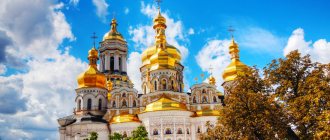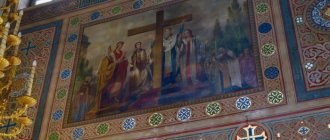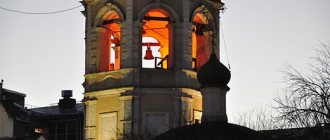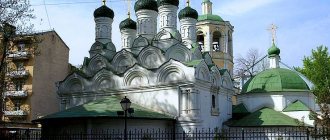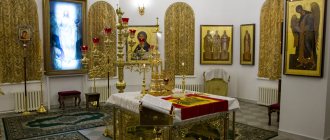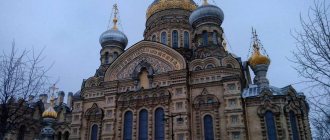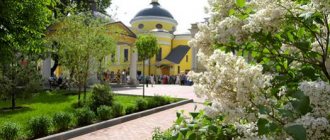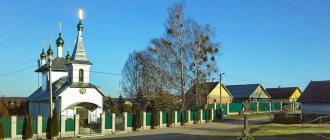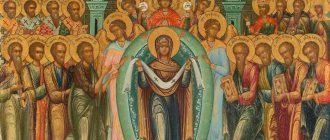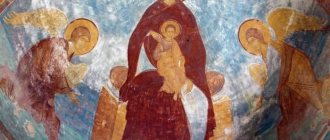Joseph-Volotsky stauropegic monastery is located 110 km from Moscow in the Volokolamsk region. On June 14, 1479, the Monk Joseph chose a place and began construction of the first wooden church and cells for the brethren. This date is celebrated annually in the monastery as its foundation day.
Reverend Joseph of Volotsky is a revered saint in the Orthodox Church and one of the outstanding organizers of the monastic work. Erudite and educated, the Monk Joseph was a polemical theologian who played a major role in defending Russian Orthodoxy from so-called heretics and disintegration. The book of his authorship, “The Enlightener,” includes the teachings and sayings of Joseph. While managing the monastery, the Monk Joseph did a lot for the residents of the surrounding villages. He helped the peasants with seeds, implements, and taught farming techniques. in times of famine, up to 700 people received food at the monastery.
© Sonic_off
Every year on October 31, the procession of the cross marks the day of the discovery of the relics of St. Joseph of Volotsky. The reliquary with the relics is considered the main shrine of the monastery. Veneration of the relics is one of the goals of pilgrims coming to the monastery from different places. Important and revered shrines of the Volotsk monastery are also the chains of St. Joseph and the Volokolamsk Icon of the Mother of God.
History of the monastery
Figure 1. Joseph Volotsky
The creator of the monastery was Joseph Volotsky. This man is glorified by the church in the ranks of the venerable saints. He lived in the 16th century and came from a noble family with Lithuanian roots. Joseph was the first person in his family to take monastic vows. Subsequently, several more men from this family followed his example.
For a long time he lived in the Savvina monastery and was even its abbot. However, the strict ascetic way of life that Joseph started did not please the rest of the brethren. And the monk left the monastery in order to found his own Volokolamsk monastery. It is also called Joseph-Volotsky.
A strict way of life was established in this monastery from the very beginning. The Monk Joseph accepted into it all the monks who wanted to settle here. The saint gave most of the monastery's budget to the needy.
Interesting! The construction of the monastery progressed at a rapid pace. The first wooden temple was erected here in just two months. In less than seven years, a stone church was built. The icons for this cathedral, as well as the frescoes, were painted by the outstanding icon painter Dionysius, a student of Andrei Rublev.
Subsequently, a high bell tower in the shape of an octagonal tower was built near the temple. The Ivan the Great Bell Tower in Moscow was built according to its model. At the base of this tower was the Church of the Icon of the Smolensk Mother of God.
JOSEPHOV VOLOKOLAMSKY (VOLOTSKY) IN HONOR OF THE DORMSION OF THE HOLY VIRGIN MONASTERY
According to V. O. Klyuchevsky, “not a single Russian monastery has discovered literary excitement equal to that which we find in the monastery of Joseph” (Klyuchevsky V. O. Old Russian Lives of Saints as a Historical Source. M., 1871. P. 292). In the development of I. V. m. as a center of bookishness, three stages are traditionally distinguished: the stage of the formation of the book core of the library and the formation of lit. traditions associated with the name of St. Joseph; flourishing lit. creativity in the 20-80s. XVI century, associated with the names of Metropolitan. Daniel, Novgorod Archbishop. Feodosius, abbots Nifont (Kormilitsyn), Euthymius (Turkov), etc.; period from end XVI century, when I. V. m. performed mainly the role of “guardian of books” (Dmitrieva R. P. Joseph-Volokolamsk Monastery as a center of books // KTsDR: Joseph-Volokolamsk Monastery as a center of books. 1991. P. 6). The main sources for the formation of the library were the correspondence of books in the monastery and deposits. According to the Charter of St. Joseph, the monks were allowed to have books and icons, so one of the sources of replenishment of the monastery’s library was the cell meetings of monks.
St. Joseph brought from 10 to 13 books to the founding site of the monastery (Zhmakin. 1881. Appendix XIX. p. 57). In I.V. m. prp. Joseph copied books, although his undisputed autograph has not been established. According to the inventory of 1545, abbot. Joseph copied 3 Gospels, Apostle, Theotokos, Triodion, Psalter, Ladder, Sobornik, Canon (Inventory of books of the Joseph-Volokolamsk Monastery of 1545 // KTsDR: Joseph-Volokolamsk Monastery as a center of book learning. 1991. pp. 24, 26- 28, 31). By 1915, the monastery library contained manuscripts that were considered the autographs of St. Joseph: Lenten Triodion, 2 Psalms, Theotokos, “Illuminator”, as well as 2 copies of the Charter, Epistles of the book. B.V. Kutuzov, I.I. Tretyakov and led. book Vasily III Ioannovich (St. Joseph, Volokolamsk Wonderworker. 1915. P. 116-119). In general, during the period of the abbess of St. Joseph's monastery housed one of the best collections, not inferior to the book collections of the Trinity-Sergius and Kirillov Belozersky monasteries.
I.V.M., as a center of bookishness, is characterized by 3 features: firstly, the influence of his tonsures on the development of journalistic thought in the 1st half. XVI century; secondly, “the tradition of honoring one’s mentors by including their works in the manuscripts created in the monastery and caring for the manuscript heritage”; thirdly, the presence in the four collections rewritten in I. V. m. of lists of works that are chronologically close to the author’s text.
An indicator of the level of organization and active use of the monastery library is compiled in the 3rd quarter. XVI century small-format “index” (RGB. Vol. No. 423). The monthbook and the Paschal part of the triode troparion of the Jerusalem Rule are taken as a basis, which are provided with references (indicating sheets) to the manuscripts of the collection containing the corresponding lives, teaching and laudatory words.
“Epistle of Joseph to Bishop. Suzdal Nifont and Andronikovsky archimandrite. Mitrofan regarding the heresy of the Judaizers." List from “The Enlightener” by Joseph Volotsky of the 16th century. (RGADA. F. 181. D. 591. L. 784) “Epistle of Joseph to Bishop. Suzdal Nifont and Andronikovsky archimandrite. Mitrofan regarding the heresy of the Judaizers." List from “The Enlightener” by Joseph Volotsky of the 16th century. (RGADA. F. 181. D. 591. L. 784)
In the library of the I.V.M. there were the oldest copies of the Charter (RNB. Solov. No. 326/346; GIM. Eparch. No. 341), “The Enlightener” (GIM. Eparch. No. 339, 340; RNL. Solov. No. 326/346) and other works of St. Joseph Volotsky (Dmitrieva. 1974. P. 208-209). The main fund of the handwritten heritage of the founder of the monastery (represented by 29 manuscripts), including an extensive epistolary and journalistic heritage, was created and preserved only in the I. V. m. (Ibid., p. 209). The monastery's tonsures often included works by St. Joseph Volotsky and brief biographical information about him. The largest number of works by Rev. Joseph (18) is in the collection of abbots. Nifont (Kormilitsyn) (RNB. Q.XVII.64). The owners of other collections, which included works by St. Joseph, were archbishop. Theodosius, Martin (Rykov) and abbot. Evfimy (Turkov). The tendency to glorify the founder of the monastery was also manifested in the creation of works dedicated to his life and work. Already in the 30s. XVI century a short chronicler appeared (Zimin. 1950. pp. 4-5), then rewritten in 14 Volokolamsk manuscripts. No later than 1531, the “Elocution” of St. Petersburg was created. Joseph of Volotsky, which goes back to the unpreserved “Tale of the Venerable Abbot Joseph of the Monastery of the Most Pure Mother of God, whom he himself created, and his holy body was placed in him” (Kloss. 1980. P. 63). Written mon. Dositheus (Toporkov) “Funeral Sermon” by St. Joseph and the service of St. Photius compiled by Elder. Joseph were preserved in 4 collections of the 60-90s. XVI century The only copies preserved are the Life of St. Joseph, written by Bishop. Savva, and Life, created by an unknown author. Among the scribes, I.V.M. is the brother of St. Joseph Vassian (Sanin), author of the Life of St. Paphnutius Borovsky. The I.V.M. carefully preserved the manuscripts that belonged to him, including the Irmology, rewritten by Vassian (Sanin) (RGB. Vol. No. 245/66).
In the book collection, in addition to the traditional liturgical books for the monastery, a large role belonged to others, among which patristic ascetic literature predominated. The most popular authors of ascetic works in I. V. m. were the Venerable John Climacus, Isaac the Syrian and Simeon the New Theologian (Alexandrova, Suzdaltseva. 1999. pp. 63-64).
In I.V.M. manuscripts were copied on orders from other Mon-Reys and individuals, and also, possibly, for sale and donations to monasteries and churches. Considering the enormous work and large number of manuscripts created by the Volokolamsk scribes, there was a scriptorium or even several scriptoriums in the monastery. Books for the monastery were ordered from other places. So, in the end. XV - beginning XVI century Stefan Tveritin, “Deacon Mikhailovsky with Senya,” copied books for I.V. Monks-scribes were engaged in copying books, along with them artisans worked for money or for allowance. Judging by the account book of 1590 by Paisius (Michurin) (RGADA. F. 1192. Op. 2. No. 1), there was a custom in the monastery to invite icon painters who knew how to write in gold screens, lines and words in manuscripts. The servants and kryloshans from the Solovetsky, Sviyazhsky, Khutynsky, Siysky and other monasteries lived in the I.V. m., who were engaged in copying books for a fee. In the monastery library there are manuscripts copied in notebooks; up to 13 handwritings of the scribes who worked on the text vary (Kloss. Nil Sorsky and Nil Polev. 1974. P. 163; Kukushkina. 1999. P. 118-119). In the I.V.M., with its strict regulations, book writing could also serve as a form of student obedience. So, in 1564-1565. the disciple of Elder Gerasim (Lenkov) Markell (possibly the future abbot of the Selizharovsky monastery in the name of the Holy Trinity) copied in small handwriting a large-format Obikhod (1143 sheets) (RGADA. F. 381 (Syn. typ.). No. 220).
Already by the time of the death of St. Joseph in the monastery library there were more than 100 books, and it was actively replenished through contributions and correspondence. By 2011, more than 100 names of scribes had been identified. Judging by the 248 book records in that part of the monastery library, which is kept in the State Historical Museum, at least 122 records are owned, 53 were left by manuscript scribes, 48 records were made by depositors. Comparison of records on books from the library of the monastery, which is stored in the State Historical Museum, with information from loose books and synodics made it possible to obtain information about 162 scribes, depositors and owners of manuscripts (Dianova T.V., Kostyukhina L.M. Records as one of the codicological features of the manuscripts of the Joseph-Volokolamsk library // Tr. GIM. M., 1989. Issue 71. P. 28; They are also. Manuscript books of the Joseph-Volokolamsk library // KTsDR: Joseph-Volokolamsk Monastery as a book center, 1991, pp. 102-116).
Among the copyists of books, Elder Gerasim Cherny occupied a prominent place, having copied 16 manuscripts. Monk rewrote at least 10 books. Dosifey (Toporkov), 12 - abbot. Euthymius (Turkov), 13 - Elder Photius, 14 books - Nile (Polev). Among the first scribes who participated in the copying of books were Gerasim Popovka, monks Gelasy (Sukolenov), Gerasim (Zamytsky), Tikhon (Zvorykin), Ferapont (Obukhov), Varlaam (Krivoshein), John (Pishchulin), Simeon the Hermit, Ephraim Tveritin, Isaiah White.
Elder Nil (Polev) was a famous calligrapher and spent some time in the Volga hermitages, working on collections of Greek lives. saints together with St. Neil Sorsky. The result of these works were 3 manuscripts (collections) taken away by St. Nile from Beloozero and in 1513-1514. invested in the form of a contribution to the I.V.m.T.o. in the monastery there were 2 volumes of the “Collection” of St. Nil Sorsky (GLM. ROF 8354. No. 14 and RSL. Vol. No. 630) and one of the early copies of the “Enlightener” and a brief edition of the Charter of St. Joseph (RNB. Solov. No. 326/346) (Prokhorov G. M. Autographs of Nil Sorsky // PKNO, 1974. M., 1975. P. 37-54). Probably, the Josephites completed one volume of the Sobornik: they selected words and teachings that supported the ideological concept of St. Nile (Lönngren T.P. “Collection of Lives” in the literary heritage of Nile of Sorsky: (On the autograph material stored in the Volokolamsk Monastery) // Palaeoslavica. Camb. (Mass.), 1999. Vol. 7). Dr. autograph of St. Nil Sorsky was found in the collection of Dionysius of Zvenigorod (GIM. Eparch. No. 51. L. 173-180 volumes; Shevchenko E. E. Unknown autograph of Nil Sorsky // TODRL. 2008. T. 58. P. 913-919). In the 20s XVI century the collections contributed by Nil (Polevev) in 1513-1514 were taken to Moscow, where the scribes of the metropolitan scriptorium made copies of them (Kloss. 1980, p. 86).
Mon. Dosifey (Toporkov) in I.V. M. edited the Russian Chronograph of 1512 (preserved in extracts and processing in the list of the RSL. Vol. No. 583; information about authorship - GIM. Uvar. No. 356) and wrote a preface to it - "Exposition on the True and Orthodox Faith." Perhaps at the monastery he also edited the Chronicle of George Amartol (Anisimova T.V. Krinitsa to the “translation” of Dosifei Toporkov?: (In the collection of MGAMID, ser. - 3rd quarter of the 16th century) // TODRL. 2006. T. 57 . pp. 166-179) and created an abridged edition of the Life of the Serbian. despot St. Stefan Lazarevich. In recent years, Mon. Dosifei compiled the Joseph-Volokolamsk patericon and the “Tombstone Sermon” of St. Joseph. Mon. Dosifei intended to transfer to the I.V. m. as a contribution the Psalter, the Znamenny Stichiral and the Explanatory Ladder (Synodik. 2004. pp. 163-164). Dosifei's collaborator in the copying of 2 manuscripts was Gerasim (Zamytsky), who rewrote at least 5 manuscripts in whole and in part for the monastery library. Gerasim, being the archimandrite of the Simonov Monastery, contributed to the I.V. m. The Four Gospels of Barlaam the Dobroscribe (RSL. Vol. No. 17). Ferapont (Obukhov), whose hand wrote the Lives of St., also took part in the correspondence of the chronograph sources. cor. Stefan Dechansky and Hilarion, bishop. Meglensky (L. 263-377 volumes), in the collection of the Russian State Library. Vol. No. 655 (cf.: Kloss B.M. Preface to the 2005 edition // PSRL. 2005. T. 22 (Russian chronograph). P. XII-XIV). Among the surviving collections of Dionysius of Zvenigorod is Eparch. No. 348, 351, 405; RSL. Vol. No. 661; F. 711. No. 53 (Ankhimyuk. 1999. P. 75-76; Dmitrieva R.P. Dionisy Zvenigorodsky Lupa // SKKDR. Issue 2. Part 1. P. 191-192).
The most prolific author among those tonsured by I.V.M. was Metropolitan. Moscow Daniel, who copied a number of books while in the monastery (in 1511-1522 hegumen, in 1539-1547 he lived in retirement), and gave 7 books as a contribution (for more details, see: Turilov A. A. Daniel’s literary heritage, book writing / / PE. T. 14. P. 72-75). Daniil compiled a number of collections with his works: RSL. MDA. Fund. No. 197; RNB. Soph. No. 1281; Weather No. 1149; QI 1439. Daniel paid considerable attention to editing books. Editorial notes that he made while living in I.V. m. are in the collections: RSL. Vol. No. 149, 489, 490, 573, 597, 605; State Historical Museum. Eparch. No. 380, etc. Apparently, it was Daniel who restored the deleted fragments of the text containing attacks against Metropolitan. Zosima (Bradatiy), in “The Tale of the Newly Appeared Heresy” from the composition of “The Enlightener” (Pliguzov A.I. “Book on Heretics” by Joseph Volotsky // History and paleography. M., 1993. Issue 1. pp. 110-112 ; State Historical Museum. Eparch. No. 337. L. 5 vol., 11 vol., 12 vol.). During his stay at the Moscow department, Metropolitan. Daniel involved the scribes I. V. m. in the work of the lord’s scriptorium. One of his assistants in the work on the consolidated Helmsman was the abbot. Nifont (Kormilitsyn), who later compiled his own edition of this canonical collection (RSL. Egor. No. 156). Igum. Nifont “sought not just to enlarge the library, but to collect and preserve in the monastery a repertoire of literature that was of interest to the educated circle of Josephites” (Dmitrieva R.P. Joseph-Volokolamsk Monastery as a center of book learning // KTsDR: Joseph-Volokolamsk Monastery as Book Center, 1991, p. 10). In the 16th century A professional scribe, clerk Dmitry Lapshin, worked for the library of I.V. He took part in the writing of at least 12 manuscripts. Along with him, Foma Shmoilov (Shmoilov), a scribe and owner of a cell library, worked. Metropolitan Daniel involved him in the work of compiling the Nikon Chronicle (Kloss B.M. About the manuscripts written by clerk Dmitry Lapshin // AE for 1974. M., 1975. P. 136-142; He. 1980. P. 82-84) . The owners of four collections of “encyclopedic” content were famous elders: Jonah (Pushechnikov) owned the RSL collection. Vol. No. 535, Dionysius Zvenigorodsky - RSL. Vol. No. 661 and State Historical Museum. Eparch. No. 405.
Charter of Rev. Joseph Volotsky. List from The Enlightener. 1514 Contribution of Mon. Nile (Poleva) in Josephov Volokolamsk Monastery (RNB. Solov. No. 326/346)
Charter of Rev. Joseph Volotsky. List from The Enlightener. 1514 Contribution of Mon. Nile (Poleva) in Josephov Volokolamsk Monastery (RNB. Solov. No. 326/346)
I. V. M. was one of the centers of all-Russian. chronicles. According to B. M. Kloss, the code of 1495 was compiled in I. V. m., since there are 3 lists of this code (RGADA. F. 196 (Mazur). No. 289; collection of MGAMID. F. 181. No. 365 ; collection Museum. No. 5837) comes from this monastery (Kloss B.M. About the time of creation of the Russian chronograph // TODRL. 1971. T. 26. P. 244-255; Same. 1980. P. 25- 29; Aka. Preface to the 2007 edition // PSRL. 2007. T. 27. P. VIII). Kloss’s opinion was refuted by R.P. Dmitrieva, who pointed to the Moscow, and not the Volokolamsk, origin of some news (Dmitrieva. 1974. pp. 225-226). By 2011, a connection was revealed between a number of monuments of metropolitan origin from the time of Metropolitan. Daniel with book-writing and lit. tradition of I. V. m. (Kloss. 1980. P. 81-87). The Simeonov Chronicle was written in the monastery by clerk Dmitry Lapshin in the 40s. XVI century (Ibid. p. 25). Of those who compiled brief chroniclers in I.V. m., Mark (Levkeinsky) (RSL. Vol. No. 515; Zimin. 1950. P. 9-14) and Ignatius (Zaitsev) (RSL. Vol. No. 362) are known. ). Information related to I. V. m. is also contained in the Book of Hours of Ignatius (Zaitsev) (GIM. Eparch. No. 264).
The tonsures of I.V.M. were in communication with other book centers. A feature of the book collection of I. V. M. “is the presence in its composition of a large number of lists of South Slavic original and translated works that came to Rus' in the end. XV century (lives of Bulgarian and Serbian saints, translated chronicles, “Serbian” Alexandria)” (Turilov. 1986. T. 1. Issue 2. P. 152) and served as sources for the Russian chronograph. In addition to close cooperation with the Novgorod Bishops' House of the times of Saints Gennady (Gonzov) and Macarius, as well as with the metropolitan scriptorium of the times of Metropolitans Daniel and Macarius, new book contacts of the monastic tonsures became known. Almost from the beginning of its existence, I.V.M. maintained close book connections with the Trinity-Sergius Monastery. The Psalter from the turn of the 15th and 16th centuries, rewritten by Gerasim (Zamytsky) and Gerasim Cherny (RGB. Vol. No. 152; State Historical Museum. Eparch. No. 90), reflects the features of the “Psalter of Metropolitan. Cyprian" 1st quarter. XV century (RSL. MDA. Fund. No. 142), stored in the Trinity-Sergius Monastery. Collection of the 20s. XVI century (RGB. TSL. Fund. No. 686) contains the senior copy of the abridged edition of the Life of Despot Stefan Lazarevich, probably created in I.V. m., and the Life of St. cor. Stefan Dečanski and Bishop. Hilarion of Meglensky probably go back to the collection of the Russian State Library. Vol. No. 655. Brief chroniclers of the monastery testify to close ties with the Borovsky monastery (Dmitrieva. 1974. pp. 223-225). One of the early copies of the “Illuminator” (RNB. Solov. No. 326/346) was rewritten no later than 1508 by St. Nil of Sorsky and Nil (Polevev) in the Sorskaya desert, which allows us to talk about close contacts between the disciples of the Monks Joseph and Nil of Sorsky. The study of the indices of true and false books that were copied in the I.V.M. made it possible to trace the borrowing and enrichment of the Cyril book tradition by the monks of the monastery. Marked lit. contacts of the brethren I. V. M. and Pavlov of the Obnorsky Monastery (Gritsevskaya I. M. Indexes of true and false books in the Volokolamsk Monastery // TODRL. 2007. T. 58. P. 494-504; Pigin. About literary Contacts, 2006, pp. 99-104).
A. A. Zimin (Zimin. Large feudal estate. 1977. P. 276). These manuscripts contain: treatise of St. Joseph in defense of monastery property (RSL. Mus. No. 1257. L. 264-297), “Conciliar response” of 1503 (RSL. Vol. No. 514. L. 426-433), “Response” of Macarius, justifying the right of the monastery -rei to own villages (RSL. Muz. No. 1257. L. 154-178), resolutions of Stoglav (RSL. Vol. No. 517. L. 206-209), “The Word is Brief”, which defended the inviolability of monastery possessions (RSL. Muz. No. 1257. L. 191-249), collection of Khan's labels in Russian. metropolitans (GIM. Sin. No. 672. L. 694-707) and “The Gift of Constantine” (Ibid. L. 668-682).
The compilers of these collections sought to include contemporary works. Thus, in the collection Vol. No. 659 contains early lists of the Life of St. Mikhail Klopsky, as edited by V. M. Tuchkov, Life of St. Paphnutius Borovsky, St. Pavel Obnorsky and a number of chronicle articles extracted from the chronicle collections created at that time. The compilers of the collections were concerned about general events. meanings. This interest was due to the direct participation of his tonsures in the political life of the state. Igum. Nifont (Kormilitsyn) included in his collection stories about the campaigns against Kazan in 1550 and 1552, in which he took part (Kuntsevich G.Z. Little-known records about the Kazan campaigns of 1550 and 1552 // ZhMNP. 1898. July pp. 135-145). Ignatius (Zaitsev) kept chronicle records (RGB. Vol. No. 362; State Historical Museum. Eparch. No. 264), including about events in Kazan. Art. “The installation of the great princes of the Russians, where and how they began to be appointed to the great reign by the holy barmas” is in 3 collections (GIM. Eparch. No. 379; RSL. Vol. No. 572; RNL. QI214), contemporary with the wedding of John IV to the kingdom. “The Legend of the Princes of Vladimir” was also preserved in the monastery in 3 relatively early copies (Dmitrieva. 1974. P. 221). A number of Volokolamsk collections (RGB. Vol. No. 488, 489, 506, 522, 530) include articles similar in content to Byzantium. "princely mirrors". Among them are “Exposition of the deliberative chapters to King Justinian composed by Agapit the deacon”, “Basily the Greek king’s headship teaching 66 to his son Leo”, “Socrates the wise man of Greece”, “Aristotle the philosopher from the epistole to Alexander the Great”, “Gennadius, Patriarch of Constantinople, word about faith”, “Message of the Patriarch of Constantinople Photius to the Bulgarian Prince Michael Boris”, etc.
Eschatological subjects, reflected in the Joseph-Volokolamsk patericon, received special attention from the scribes of I.V. From the monastery comes a story of the patericon type “On the repose of Elder Anthony of Galicia” (Pigin. Visions of the Other World. 2006. pp. 23-156). Volokolamsk scribes preferred stories with edifying content; translated works were often revised in order to impart the greatest moralizing meaning. In the monastery, 2 editions of the translated story “The Debate of the Belly and Death” were created, as well as Russian. edition translated from Polish. language “Tales of the Death of a Certain Master Philosopher” (Dmitrieva R.P. Russian translation of the 16th century Polish work of the 15th century “The Conversation of Master Polycarp with Death” // TODRL. 1963. T. 19. pp. 303-317; Stories about the dispute between life and death / Research and preparation of texts: R. P. Dmitrieva. M.; Leningrad, 1964. pp. 24-59). I. V. Knizhnikov was also distinguished by his interest in unusual natural phenomena (earthquakes, solar and lunar eclipses). Dionysius of Zvenigorod (State Historical Museum. Eparch. No. 405) and abbot. Nifont (Kormilitsyn) (RNB. Q.XVII.15) in their collections included articles from 1524 about a flood in Naples and an earthquake in Hungary, about a heavenly sign in Riga, about an earthquake “in the Roman land of the city of Shimboria and in the land of Tours the death city of Thessaloniki."
In 1551-1563 in I.V.m. in the cell of the retired Novgorod archbishop. Feodosia operated a small scriptorium. The archbishop was assisted by his disciples, abbots. Evfimy (Turkov) and Jeremiah. There are 5 known books from the library that belonged to the archbishop. Feodosia: RSL. Vol. No. 41, 514; State Historical Museum. Music No. 791; Eparch. No. 171 and RSL. F. 722. No. 702 (Ankhimyuk. 1999. P. 77-78). According to Zimin, Archbishop. Theodosius rewrote the collection of the State Historical Museum. Syn. No. 791. The bishop partially rewrote the manuscripts of the RSL. Vol. No. 514 (L. 223-223 vol., 226 vol., 233 vol. - 235 vol., 238 vol.); 572 (L. 234 vol.); RNB. Q.XVII.50 (L. 273 vol., 341-342, 343) (Kloss. Nil Sorsky and Nil Polev. 1974. P. 162). According to Dmitrieva, former archbishop Theodosius included the abbot in the collection of his student. Euphemia (Turkova) his works (RNB. Q.XVII.50. L. 267-273, 341-345 volumes), and also left an autograph in the manuscript of the State Historical Museum. Eparch. No. 416 (Dmitrieva. 1974. P. 205, 213-214). All R. 50s XVI century abbot. Evfimy helped the archbishop. Theodosius in the correspondence of the Lenten Triodion (State Historical Museum. Eparch. No. 70). Between 1 Sep. 1562 and 26 Feb. 1563 collection Vol. No. 514 was completed by the students of the archbishop. Feodosia abbot. Evfimy and bud. archbishop Kazansky Jeremiah. At the same time, Euthymius completed work on another collection (RNB. Q.XVII.50), which contains a corpus of messages from the archbishop. Feodosia. Apparently, in the cell of the archbishop. Feodosia, a collection was compiled (GIM. Syn. No. 791), in which on sheets 95-164 contains materials from the archive of St. Maxim the Greek.
In 1563, abbot. Evfimy (Turkov), with the blessing of his teacher, Archbishop. Theodosius rewrote the Book of Hours (GIM. Eparch. No. 256). In the collection of his student Levkiy (Akishev) abbot. Euthymius wrote the story “On the Repose of Elder Theodosius,” which represents the Life of the Archbishop. Feodosia (RGB. Vol. No. 512). In the collection of the RSL. Vol. No. 572 abbot. Euthymius rewrote the “Funeral Sermon” of St. Joseph Volotsky. Probably at the end. 70s XVI century Euthymius revised the 2nd edition of the Menaine Life of St. Joseph Volotsky (Popov. 1914). Perhaps in the 70-80s. XVI century Euthymius, by contaminating the “Tombstone Oration”, the 2nd edition of the Menaion Life and some texts, created a new edition of the Life of St. Joseph (the oldest list is the RKP. RNB. Soph. No. 451/1. L. 89-128 vol.; Pliguzov. Second edition of the Menaic Life. 1984. P. 29-53). Igum. Euthymius did a lot of work to streamline the monastic documentation. In 1573, together with the book guardian Pafnuty (Rykov), he compiled an inventory of the books of the library. With abbot. Euphemia compiled the “Old Feed List,” which combined the synodik and the fodder book (GIM. Eparch. No. 1). At the same time, a new list was compiled (GIM. Eparch. No. 415), in which the names and surnames of the first investors, as well as the days of their commemoration, are indicated. This work continued: notebooks were compiled (RGB. Vol. No. 681; RGADA. F. 1192. Op. 2. No. 482) and Obikhodnik (GIM. Sin. No. 829). Igum. Euthymius compiled the Canon (RGB. Vol. No. 412), in which, in addition to the services of St. Euthymius the Great and St. Joseph of Volotsky included a spiritual letter, a dying confession, canons on the outcome of the soul and for a deceased friend, and short obituaries for monks who died during the abbotship of Euthymius. As contributions from Abbot. Euthymius gave the monastery 7 books, 4 of them “his letters.” Autographs of abbots are also known. Euphemia (RGB. Vol. No. 133, 213, 566; GLM. No. 204).
In the 20-40s. XVI century Vassian Koshka worked in I. V. m., who completely or partially rewrote 8 books (GIM. Eparch. No. 114, 231, 258; Syn. No. 927; RSL. Vol. No. 511, 517, 530; Music No. 1257) . The authorship of Vassian is considered established in relation to the Life of St. Photius, a student of Cassian the Bosom (GIM. Syn. No. 927. L. 171-178), and the words “On the repose of St. Ep. Tverskoy Akaki and about his life in brief" (RNB. Weather. No. 1564. L. 52-56 vol.). Vassian’s authorship in relation to the Dictionary Code, the Life of Cassian the Barefoot, the letter “about the dislikes of the monks of the Kirillov and Joseph monasteries” is doubtful (Dmitrieva R.P. Vassian Koshka // SKKDR. Issue 2. Part 1. pp. 119-120). In 1563-1564. Vassian kept notes in a loose book (GIM. Eparch. No. 419. L. 1-6, 128-129 vol.). He rewrote the above-mentioned articles, as well as the 11th Word from the spiritual letter of St. Joseph Volotsky, “A Brief Word” in defense of monastery property, “The Tale of St. Paphnutius Borovsky" and others. The most interesting are the collections of Vassian (GIM. Syn. No. 927 and RSL. Music. No. 1257), compiled mainly from the works of the inhabitants of I.V. m. or from works dedicated to them. Dr. Volokolamsk book writer ser. 16th century - monastery servant and “book master” Foma Vasilyev Popov is known only from the “sales” entry of 1555/56 on the Gospel from the library of the Hilandar monastery on Athos (No. 66) (see: Bogdanov D. Catalog Cyrillic manuscripts of the Hilandar manastir (Beograd, 1978, p. 71).
Deposits were an important source of replenishment of the library. “Any somewhat outstanding historical figure who came out of the Volokolamsk community certainly continued to maintain contact with it and finally added his name to the number of monastic investors with books and money” (Zhmakin. 1881. P. 119). Novgorod Archbishop Theodosius handed over 22 books, Archimandrite. Alexy (Stupishin) - 14, ep. Ryazan Leonid (Protasyev) - 20, archbishop. Polotsk Trifon (Stupishin) - 11, archbishop. Kazansky Lavrentiy - 12, abbot. Joasaph (Lukovnikovsky) - 15 books. Among the secular persons who made contributions to the monastery with books were B.V. Kutuzov, clerk D. Mamyrev, Prince. D. I. Obolensky. After the death of the owners, cell meetings were transferred to the library. Thus, the cell collection of Elder Dionysius of Zvenigorod consisted of 10 books, Arseny (Pleshcheev) - 12, Paisius (Michurin) - 13 books.
Among the surviving rare monuments of the monastery library is one of the senior copies of “Tales of the Indian Kingdom” (RGB. Vol. No. 309), draft texts of the Russian chronograph (Ibid. No. 583), the senior copy of “The Tale of Mercury of Smolensk” (Ibid. same. No. 577), the oldest complete set of Chetyih-Menya (Ibid. No. 590-598). The only known list of beginnings is kept in the monastery library. XVI century a special edition of the Chronicle of John Zonara (“Paralipomenes”) with an afterword by the editor and scribe of 1408 (RGB. Vol. No. 655), as well as the only list translated from Greek. language proskinitary “Adoration of St. city of Jerusalem 1531" (RGB. Vol. No. 387. L. 632-648; publ.: Golubtsova M. A. On the question of the sources of ancient Russian walks to the Holy Land. Worship of the Holy City of Jerusalem in 1531. M., 1911). The oldest known manuscript of the “Peace-Making Circle” (GLM. No. 142) comes from the library of I.V.M. The collection of Dionysius of Zvenigorod (RGB. Vol. No. 661) contained the main list of “Tales of the Massacre of Mamayev.” The Volokolamsk collections also contained the earliest lists of the Lives of St. Euphrosyne of Suzdal, St. Euphemia Suzdalsky, as well as the original edition of the Tale of Nikola Zaraisky (Kloss B.M. Selected works. M., 2001. T. 2: Essays on the history of Russian hagiography of the XIV-XVI centuries. P. 371, 375, 417-418). The October volume of the Menaion-Chetya (RGB. Vol. No. 591) includes the oldest Russian and one of the oldest in the entire manuscript tradition list of the Life of St. John of Rylsky, edited by George Skilitsa.
The general book fund of I.V.M. consisted of books located in the library, in cells, in the courtyard in Moscow and in the churches of nearby estates. Throughout the 16th century. An inventory of the library was compiled three times. In the first of the known inventories (compiled by Elder Zosima and book guardian Paisius), which dates back to 1545 (1575?), there are 930 manuscripts and 2 early printed books (Georgievsky. 1911. App. pp. 8-23; Inventory of the books of Joseph- Volokolamsk Monastery 1545 / Publ.: R. P. Dmitrieva // KTsDR: Joseph-Volokolamsk Monastery as a center of book learning. 1991. pp. 24-41). By 2011, the location of this inventory is unknown (Sharomazov M.N. “Ours”, or “Peace”: (On the time of creation of the inventory of the Joseph-Volokolamsk monastery, published by V.T. Georgievsky) // From the Middle Ages to the New Age : Collection of articles in honor of O. A. Belobrova, M., 2006, pp. 571-586). According to the 2nd inventory (1573), compiled by the charterer Euthymius and the book guardian Paphnutius (Rykov), there were approx. 1150 books, of which 32 were printed (Kazansky P.S. Inventory of books of the Joseph-Volokolamsk Monastery in 1573 // CHOIDR. 1847. No. 7. Dept. 4. P. 1-16). The compilation of the inventory of 1591 is associated with the activities of Elder Misail Beznin (Dmitrieva R.P. Inventories of manuscripts of the Joseph-Volokolamsk Monastery of the 16th century // KTsDR: Joseph-Volokolamsk Monastery as a center of book learning. 1991. P. 20). According to Zimin’s calculations, the inventory includes over 1050 handwritten and printed books, according to M.V. Kukushkina’s calculations - 952 handwritten and 12 printed books (Zimin. From the history of the collection of handwritten books. 1977. P. 16; Kukushkina. 1999. P. 100 ). K con. XVI century I. V. M. had the 3rd largest collection of books among Russians. monasteries, second only to the Trinity-Sergius and Kirillov Belozersky monasteries.
In the 17th century Book writing in the I.V.M. fell into decline. Some manuscripts were lost during the siege of the monastery during the Time of Troubles, and some of the manuscripts were taken from the monastery by monks. Several books from the monastery library were requested to the Palace Order and the Patriarchal House Treasury (RGADA. F. 1192. Op. 1. No. 4, 6. L. 35). There are 4 known inventories of the 17th century: 1637-1638, 1652, 1665, 1685. Inventory of 1637-1638 preserved in the form of extracts (RGADA. Op. 1. No. 5, 6, 10-12); the only one that has been preserved in its entirety is the inventory of 1652 (GLM. No. 8655. L. 61 volume - 78 volume; Morozov. 1999. P. 69). Information about other inventories and a copy of the inventory of 1685 are included in the manuscript of Cand. essays by MDA student N. Shchukin (RGB. F. 172. 437. 4).
Monastery today
Figure 2. Fortress wall
The monastery in question has on its territory several churches and other buildings built in the 15th and 16th centuries.
The outer walls of many churches are decorated with tiles by the artist Stepan Polubes. He is mainly known as the master who worked on the decoration of the New Jerusalem Monastery.
The Saints
The history of this monastery is connected with the lives of several righteous people, among them St. Herman, who was engaged in rewriting and interpreting church books. For several years he was Archbishop of Kazan. In the library of the monastery, many years after Herman’s death, books copied by his hand were preserved as shrines. While being a monk of the Joseph-Volotsk Monastery, he met Maxim the Greek.
This translator and interpreter of Christian literature came to Russia from Athos at the request of Grand Duke Vasily the Third. Among other things, he was involved in the translation of the Explanatory Psalter. But after some time, the monk was exiled to the Volokolamsk Monastery for criticizing part of the Russian clergy. He actively opposed the fact that some monasteries had wealth, lands and a large number of serfs.
Pilgrimage and excursions
Tourists and pilgrims coming to the Joseph-Volotsky Monastery are met and accompanied by the Pilgrimage Center. Guests are offered a one and a half hour guided tour of the monastery. Visitors are introduced to the architecture of the monastery, they visit the Assumption Cathedral, the Refectory Chamber, climb the fortress wall and the German Tower. During the excursion conversation, topics of construction, centuries-old history and revival of the monastery are touched upon, stories are told that connect the monastery with the names of many Russian autocrats. The excursions are conducted by the monastery brothers and obedient students of St. Tikhon's Humanitarian University.
Bible Museum
The first Bible museum in Russia was created in the Joseph-Volotsky Monastery. The basis of the collection is the extensive library of Metropolitan Pitirim of Volokolamsk and Yuryev, the abbot of the monastery revived in 1989. In three halls of the museum, rare and unique editions of the Bible are presented: the Ostrog Bible of 1581, the Elizabethan Bible of the 2nd century, sacred books with illustrations by Durer, drawings by Salvador Dali. The collection of early printed and handwritten books is of particular value. In past centuries, one of the main obediences of the Joseph-Volotsk brotherhood was the rewriting of books. It is believed that by the middle of the 2nd century. the monastery had the largest manuscript library.
Museum of the Bible, © Elena Younes
For pilgrims
For the convenience of pilgrims, the Joseph-Volotsky Monastery offers accommodation in a hotel at the monastery. It offers rooms of varying degrees of comfort and cost. There is free Wi-Fi, a changing table and cot for babies, kitchen equipment and all the necessary amenities. Accommodation for pilgrims must be agreed in advance by phone +7 925 112 9011 or email [email protected]
In addition to the church shop operating at the cathedral, at the entrance to the monastery there is a large church store, where you can buy icons, books, candles and monastery souvenirs every day from 10:00 to 17:00. In the monastery you can rent bicycles, and in winter - cheesecakes for riding down the mountains.
Paintings on the walls of the Assumption Cathedral on Google maps panorama
Not an easy time
Figure 3. View across the lake
Over its centuries-old history, the monastery had to go through many trials. Thus, during the “time of troubles” the monastery had to become a haven for a Polish detachment supporting the impostor False Dmitry II.
And during the Great Patriotic War, the territory of the monastery was occupied by German troops of the Center group. During the retreat of the Red Army, the bell tower was blown up, at the base of which was the Church of the Smolensk Mother of God - a masterpiece of ancient Russian architecture. From the height of this building in good weather one could see Moscow. Therefore, such an object could not be left to the enemy.
During and before the war, there was an orphanage within the walls of the monastery, and a cinema in the main church of the monastery.
Revival of the monastery
At the end of the eighties, the monastery was returned to the Russian Orthodox Church. Then, for the first time in many years, a liturgy was served there. The relics of St. Joseph, the founder of this monastery, were found here. They still rest on the territory of the monastery today. Almost all ancient churches are active and services are held in them.
However, some of them require reconstruction. The churches of the courtyard of this monastery are located in Moscow. In the early 2000s, Abbot Sergius became the abbot of the monastery.
How to get there
Address of the monastery: Moscow region, Volokolamsk district, village Teryaevo. To get to the shrine from Moscow, you first need to get to Volokolamsk by bus from the Tushinskaya metro station or by train to Chismena station. And then transfer to the bus to the village of Teryaevo.
By car from Moscow you need to drive along the Novorizhskoe highway for about 98 km, then turn right to Chismena station, and after the railway crossing continue to the village of Teryaevo, pass the village and go around the pond. Starting from the turn onto Novorizhskoye Highway there will be signs to the monastery.
May the Lord protect you!
You will also be interested in watching a video about the holy monastery:
